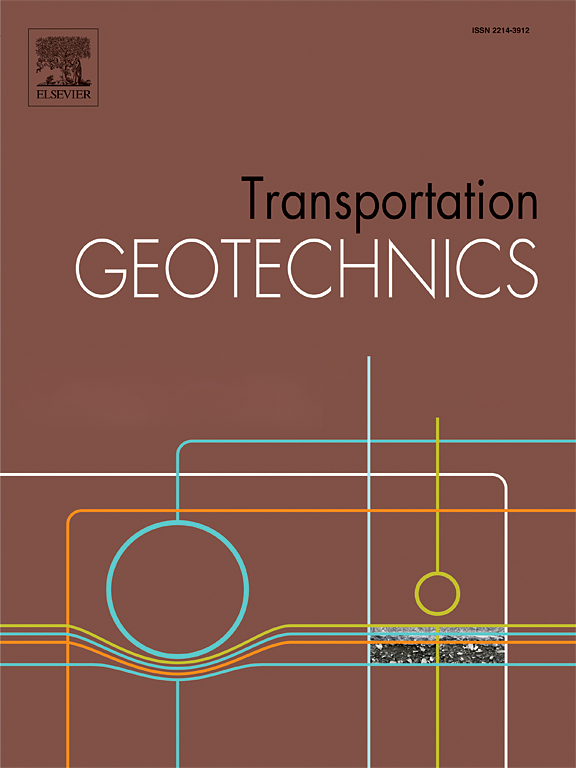Failure mechanism of deep-buried tunnel surrounding rock-lining system: physical model tests and numerical investigation
IF 4.9
2区 工程技术
Q1 ENGINEERING, CIVIL
引用次数: 0
Abstract
Lining cracking is a common failure mode in tunnel construction and operation, particularly in regions characterized by unfavorable geological conditions (e.g., weak strata), which poses significant risks to tunnel stability. This study conducted dynamic physical model tests to investigate the failure mechanisms associated with tunnel excavation within weak geological environments. During the excavation process, the deformation of surrounding rocks comprises both instantaneous and creep deformations. Utilizing similarity theory, the time-dependent creep behavior of tunnels under constant loading conditions was examined. A strain acquisition system alongside a digital photogrammetry system was employed to monitor the mechanical responses of both surrounding rocks and linings, thereby elucidating the evolution characteristics of failures during excavation. The test results indicate that stress concentration and redistribution occur in surrounding rocks post-excavation, leading to abrupt changes in strain. Following lining installation, both stress and strain fields within the cavern gradually stabilize. Notably, the rock-lining system significantly contributes to long-term tunnel stability. Subsequently, a nonlinear creep model capable of accurately describing rock creep behavior was proposed, and numerical analysis utilizing finite difference methods was performed to explore deformation mechanisms during excavation processes, revealing that failure characteristics observed in surrounding rocks align well with experimental findings.
深埋隧道围岩衬砌系统破坏机理:物理模型试验与数值研究
衬砌开裂是隧道施工和运行中常见的一种破坏形式,特别是在地质条件不利的地区(如脆弱地层),衬砌开裂对隧道的稳定性构成重大威胁。为探讨弱地质环境下隧道开挖的破坏机制,开展了动态物理模型试验。在开挖过程中,围岩变形包括瞬时变形和蠕变变形。利用相似理论,研究了隧道在恒载条件下随时间变化的蠕变特性。采用应变采集系统和数字摄影测量系统监测了围岩和衬砌的力学响应,从而阐明了开挖过程中破坏的演化特征。试验结果表明,开挖后围岩发生应力集中和重分布,导致应变发生突变。随着衬砌的安装,洞室内的应力场和应变场逐渐趋于稳定。值得注意的是,岩石衬砌系统对隧道的长期稳定性有重要贡献。随后,提出了能够准确描述岩石蠕变行为的非线性蠕变模型,并利用有限差分方法进行了数值分析,探讨了开挖过程中的变形机制,结果表明,观察到的围岩破坏特征与实验结果吻合良好。
本文章由计算机程序翻译,如有差异,请以英文原文为准。
求助全文
约1分钟内获得全文
求助全文
来源期刊

Transportation Geotechnics
Social Sciences-Transportation
CiteScore
8.10
自引率
11.30%
发文量
194
审稿时长
51 days
期刊介绍:
Transportation Geotechnics is a journal dedicated to publishing high-quality, theoretical, and applied papers that cover all facets of geotechnics for transportation infrastructure such as roads, highways, railways, underground railways, airfields, and waterways. The journal places a special emphasis on case studies that present original work relevant to the sustainable construction of transportation infrastructure. The scope of topics it addresses includes the geotechnical properties of geomaterials for sustainable and rational design and construction, the behavior of compacted and stabilized geomaterials, the use of geosynthetics and reinforcement in constructed layers and interlayers, ground improvement and slope stability for transportation infrastructures, compaction technology and management, maintenance technology, the impact of climate, embankments for highways and high-speed trains, transition zones, dredging, underwater geotechnics for infrastructure purposes, and the modeling of multi-layered structures and supporting ground under dynamic and repeated loads.
 求助内容:
求助内容: 应助结果提醒方式:
应助结果提醒方式:


